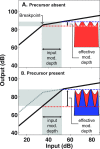Notched-noise precursors improve detection of low-frequency amplitude modulation
- PMID: 28147582
- PMCID: PMC5392086
- DOI: 10.1121/1.4973912
Notched-noise precursors improve detection of low-frequency amplitude modulation
Abstract
Amplitude modulation (AM) detection was measured with a short (50 ms), high-frequency carrier as a function of carrier level (Experiment I) and modulation frequency (Experiment II) for conditions with or without a notched-noise precursor. A longer carrier (500 ms) was also included in Experiment I. When the carrier was preceded by silence (no precursor condition) AM detection thresholds worsened for moderate-level carriers compared to lower- or higher-level carriers, resulting in a "mid-level hump." AM detection thresholds with a precursor were better than those without a precursor, primarily for moderate-to-high level carriers, thus eliminating the mid-level hump in AM detection. When the carrier was 500 ms, AM thresholds improved by a constant (across all levels) relative to AM thresholds with a precursor, consistent with the longer carrier providing more "looks" to detect the AM signal. Experiment II revealed that improved AM detection with compared to without a precursor is limited to low-modulation frequencies (<60 Hz). These results are consistent with (1) a reduction in cochlear gain over the course of the precursor perhaps via the medial olivocochlear reflex or (2) a form of perceptual enhancement which may be mediated by adaptation of inhibition.
Figures




References
Publication types
Grants and funding
LinkOut - more resources
Full Text Sources
Other Literature Sources

